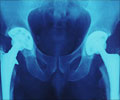
The total economic burden, including pharmaceutical prevention, of fractures in the European Union in 2010 was estimated at €39 billion EUR. The highest costs were in the EU's five largest countries – Germany (9.3 billion), Italy (7.2 billion), UK (5.6 billion), France (5 billion), Spain (2.9 billion).
The direct costs of treating new fractures accounted for €26 billion EUR, long-term fracture care €11 billion and pharmaceutical prevention only €2 billion. Excluding pharmaceutical prevention costs, hip, vertebral, wrist and "other fractures" comprised 55%, 5%, 1% and 38% of the economic burden respectively.
John A. Kanis, Professor Emeritus at the University of Sheffield, WHO Collaborating Centre, and lead author of the study, concluded, "We have found that pharmaceutical prevention of fractures only accounts for 2 billion EUR in expenditure – approximately 5% of the total cost burden of fractures. This small investment in prevention and treatment reflects the fact that osteoporosis, which is most often the underlying cause of fragility fractures, is neither being assessed nor treated in the majority of people at high risk."
The economic burden of fractures in the European Union is expected to grow as as the number of seniors increases in Europe. Studies have estimated that the number of fractures will more than double by 2050 unless preventive action is taken.
Source-Eurekalert















